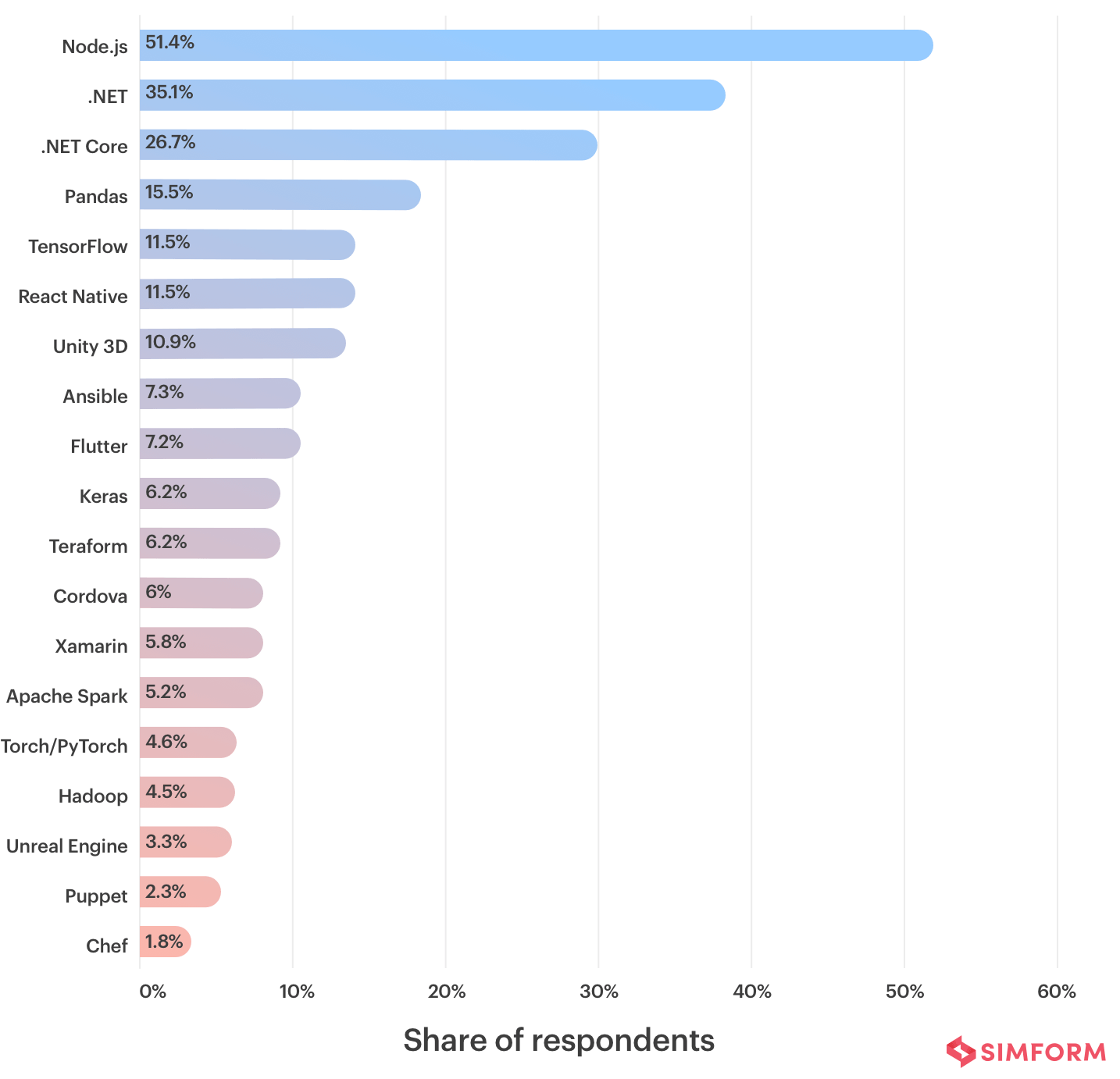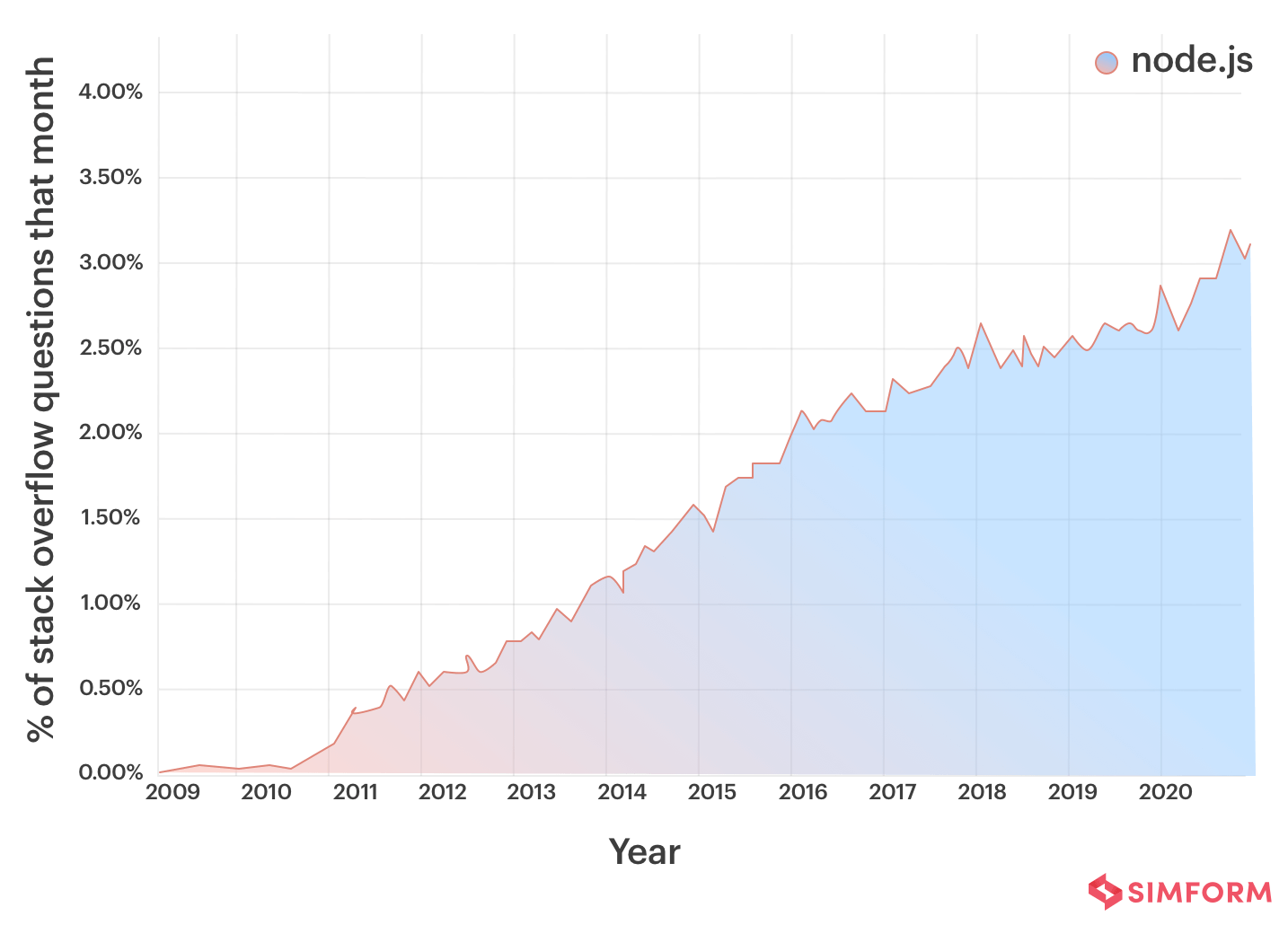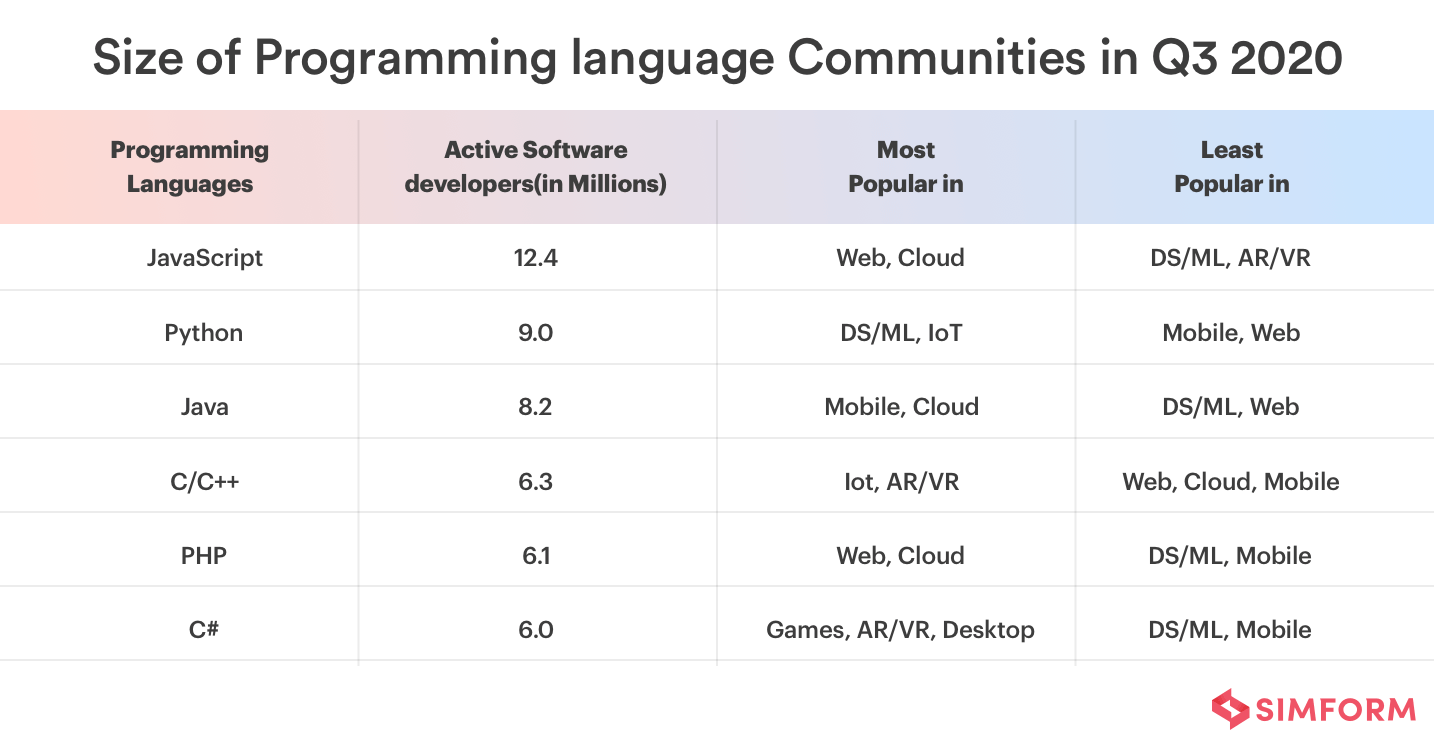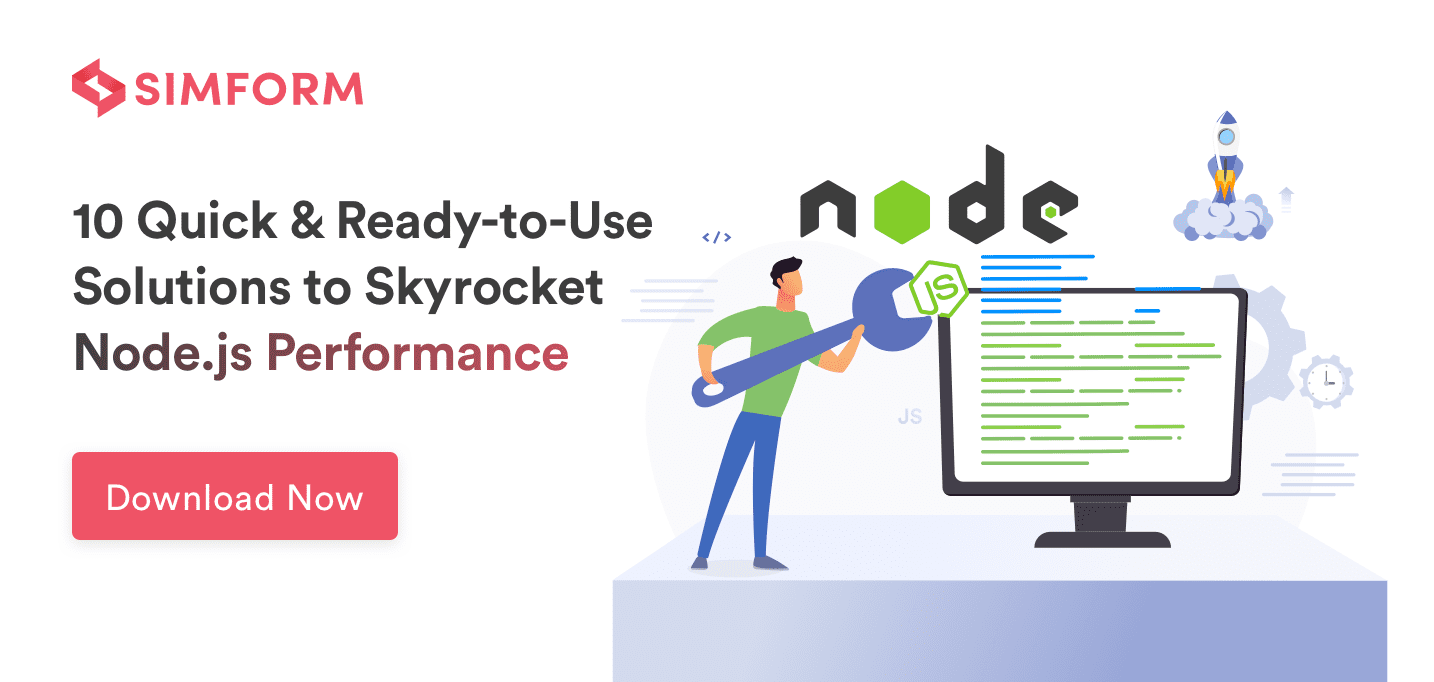If you want to compare two powerful backend technologies: Node.js vs Java and are also excited to read about how Netflix migrated from Java to Node.js, read this article.
It will introduce you to why Java is still relevant in the times of modern and scalable Node.js. And what are the areas where Node.js outperforms Java? This blog will help you decide on the backend technology for your next web app development project.
Editor’s note: In case, you’ve already decided, browse Simform’s web app development solutions and let’s get your project moving.
So, without further ado, let’s compare the crucial aspects of both tools. Starting from the overview, use cases to performance, scalability, application architecture, and many others.
Nodejs and Java – An overview
Simform helps decision makers and CTOs select the right framework based on several comparison factors. Nodejs and Java are widely preferred by developers for building interactive applications. Now without further ado, let’s take a look at what Nodejs vs Java have in store for you.
What is Nodejs? – An Overview
Nodejs is a server-side, Javascript-based runtime environment that’s a massive open-source tool. It attributes its success as a high-performance, scalable framework to the single-threaded process used for web loads and async programming. What’s more, you can use Nodejs-based frameworks such as Express, Socket.io, and Meteor.js within it to enhance the backend capability of a project. Designed with real-time and push-based architectures, the technology is known to build single-page applications, websites, and backend API services.
Here are some Market usage stats of Nodejs as a backend technology:
- 63.22% of developers rated Nodejs as the most loved tool in Stackoverflow Developer Survey Report 2021.
- 85% of Nodejs developers use it for web app development, and the other 43% use it for enterprise-grade applications.
- 51.4% of developers regarded Nodejs as the most-used tool earlier in the 2021.

- StackOverflow Trends has noted an increase in the discussion around Nodejs over the last decade covering almost 3.5% of questions.

Use cases of Nodejs
- Streaming web applications
- Real-time software & Streaming apps (Collaboration tools used for video/audio conferencing, document editing, Chat applications, etc. )
- Complex single-page apps
- Microservices
- IoT-based applications
- Backends and servers
- Developing APIs
- Scripting and automation
What is Java? – An Overview
Java is a programming language that promotes the usage of object-oriented concepts after C++. It works on the “write once and run anywhere” (WORA) principle which means that the code can run on all the platforms that support Java without the need for recompilation. Developed by Sun Microsystems in 1991 (now acquired by Oracle), Java is secure, stable, and flexible. Also, it’s a perfect fit for banking, eCommerce, FinTech, and transportation services. In the initial phases, Java was also hailed as a fine language for Android application development.
Java becomes a platform/framework when combined with a runtime environment, i.e., JVM (Java Virtual Machine). There are mainly four platforms of Java:
- Java Platform, Standard Edition (Java SE)
- Java Platform, Enterprise Edition (Java EE)
- Java Platform, Micro Edition (Java ME)
- Java FX
Here’re some market usage statistics for Java:
- Till now, Java has been heavily used by almost 4% of websites empowering the web.
- 57,739 websites use Java along with 33,093 unique domains.
- For the past nine years, Java has been ranked among the top five most used programming languages, according to the StackOverflow Annual Survey report 2022.
Use Cases of Java
- Game development
- Web app development
- Android app development
- Software tools
- Test automation
- Scientific apps
- Desktop GUI
- Applications for Enterprises
- Embedded Systems
- Application Servers/Web Servers
- Big Data Technologies
- Business Applications
- Banking and FinTech applications
Pros and Cons difference between Nodejs and Java
Before you choose a framework, it’s important that you understand the opportunities and shortcomings it brings along. This comparison between Nodejs and Java should help you select the most compatible tool for your application.
Pros of Nodejs
- Unopinionated: Builds everything from scratch with fewer restrictions, which gives developers the freedom to code their own way.
- Non-blocking I/O System: Lets you process several requests simultaneously, resulting in more scalability and faster performance.
- Active Community: Allows access to readily available solutions and codes that makes easy for startups and beginner developers.
- Easy to learn: Developers with an experience in Javascript as a frontend language can easily adapt to the framework.
- Full-Stack Privilege: Allows Nodejs developers to write frontend and backend both in Javascript. This enables smooth deployment of apps and reduces the learning curve.
- Caching facility: Caches single modules in the application memory and eliminates the need to re-execute the code for faster response times.
- Extensive support: Assists developers with commonly used tools for different purposes such as testing or identifying project dependencies.
Cons of Nodejs
- Productivity loss: Since everything needs to be written from scratch, you may experience a decline in productivity. Beginners find it difficult to build apps from scratch due to its non-opinionated nature.
- Not suitable for extensive computing: Although Nodejs supports complex apps, it doesn’t fare well with heavy computing (CPU intensive) apps. Additionally, it is less efficient at heavy calculations as it doesn’t support multi-threaded programming.
- Difficult to maintain code due to Async nature: Due to nested callbacks in Nodejs and its heavy reliance on asynchronicity, it becomes tedious to maintain and difficult to understand code.
- Some of its tools lack quality– Some Nodejs tools don’t match high-coding standards and are not correctly structured due to its open-source ecosystem.
Pros of Java
- Cost-effective Development: Java-based apps are browser and operating system agnostic when it comes to testing. Since configuration and troubleshooting is simple, the development lifecycle becomes cost effective.
- Increased Security: It allows apps to be deployed on dedicated servers. This makes maintenance and monitoring of the apps seamless for server administrators. Consequently, it eliminates the risk of most data breaches/threats.
- Better Interoperability: Apps can be easily integrated with other business apps. It makes the language interoperable for isolated desktop applications and web applications. Businesses can get a flexible and adaptable business model in a rapidly changing business marketplace due to these benefits.
- Easy to install and maintain: Once the version is installed on the host server, you can easily upgrade and add features as you want to. Even though the new software and versions can be automatically upgraded to new versions. Therefore, the new software and versions can be automatically upgraded to the new versions. This way, users can easily do upgrades and installation easily.
- Better readability: It’s easy to read, write, and debug. Java lets your developer write code that maintains the code quality for your organization.
Cons of Java
- Memory-consumption: The framework consumes more memory and is slower than other natively compiled languages such as C or C++.
- Lacks backup facilities: Java focuses on storage and not on the backup of data. It’s a significant drawback that makes it lose interest and ratings among users.
- Not good with Android API design: Starting a new project of Android with Java is not recommended as Java has limitations such as maintaining and improving the codebase become difficult when time passes, which cause problems with Android API designs.
No appealing looks & feels of the GUI: Even though there are numerous GUI builders to create graphical interface, they are not best suited for creating complex UI. Undeniably, Java consists of several popular frameworks, but they are still not mature enough to develop complex UIs.
Popular applications built with Nodejs and Java
Here’s a list of some tech giants and companies that use Nodejs and Java to meet their market needs and application development requirements.
Popular apps using Nodejs as backend technology
- NASA revealed that Nodejs made migrating data from legacy databases to a cloud database effortless. It created a single database for any query and reduced access time by a massive 300%.
- Twitter launched Twitter Lite with a 30% faster launch time and quick loading on slower connections.
- Netflix decreased startup times and significantly improved performance. They migrated their backend from Java to Nodejs that resulted in a decrease in startup time from 40 minutes to 60 seconds.
- Trello implemented instant propagation of updates. As the application organizes tasks on an agile basis, they wanted a tool that instantly reflects the updates without reloading the page.
Check how we build SentMap - a real-time sentiment-based market analytics tool using Node.js
Popular Apps using Java as a Backed Technology
- eBay managed the entire workflow for their entire tech stack, lessened the time-to-market, enhanced engineer output, and reduced collaboration costs.
- Google used Java for backend programming, user interface development, and one of the products, Google Docs.
- Spotify made app development a much easier, simpler, and straightforward process.
- Cash App used Java for most of its code since it provides flexibility across devices and out-of-the-box features to deal with bank accounts.
- Netflix relies heavily on Spring Cloud, a Java-based framework, for backend operations.
Performance comparison for Nodejs and Java
While performance should not be a killer factor for small projects, it becomes extremely important to consider it when building complex and large projects. With that being said, let’s compare Nodejs and Java in terms of performance.
How is the performance of Nodejs vs Java?
Nodejs
As it inherits the asynchronous and non-blocking from Javascript, Nodejs creates a perfect environment for small tasks (micro-operations/tasks) that don’t affect the main application thread. What’s more, applications built in Nodejs offer superior performance due to two main reasons: Multitasking and V8 Javascript engine.
- Nodejs’s event-driven architecture allows efficient multitasking, which enhances applications’ performance.
- Nodejs uses a V8 Javascript engine, which works very fast in a short ramp-up time.
The framework processes many requests simultaneously compared to other backend solutions. In fact, a large number of tech giants are turning towards Nodejs for its performance. Paypal, for one, saw a 35% drop in the average response time and doubled their requests per second. Another such example is Linkedin that reduced its servers from 30 to 3 as they migrated to Nodejs. Now doesn’t that speak volumes?
Java
Programs written in Java are written as byte codes. It means the language performs far better and faster than traditional programming languages. Virtual machines effortlessly interpret these byte-code instructions and deliver faster and more efficient applications. Furthermore, JVM is optimized to provide an efficient interpretation of code in its newer versions. Java has also introduced elements like a just-in-time compiler to deliver high-performing apps.
Application architecture – Nodejs vs Java
When choosing a framework, it’s important to choose flexibility and avoid any strict enforcement of architecture and guidelines. As a matter of fact, it’s always recommended to treat a framework as a guide, not methods and standards. That said, let’s juxtapose Nodejs and Java with each other and check whether they are flexible in terms of architecture.
What kinds of architecture does Nodejs support?
Under the hood, Node. js leverages the Single-threaded Event Loop architecture that enables it to handle multiple concurrent requests with high performance. However, Nodejs also lets you use MVC/ MVP architecture pattern, which eases isolating and onboarding issues in the application codebase. In addition to this, it creates multiple views for the same data and supports asynchronous communication between various components.
Here’s how you benefit from the async architecture of Nodejs:
- Processes multiple concurrent requests simultaneously and offers high performance.
- Ensures faster and flexible development of modules.
- Reduces time-to-market of applications.
What kinds of architecture does Java support?
Developers prefer the model-view-controller (MVC) pattern to build applications in Java since the Model represents objects in Java, and the design pattern resembles the internal architecture of the language. It promotes easy maintenance of code and trouble-free testing of applications. Development teams can classify individual roles and work on the different functionalities in large applications. So the changes made in one module don’t affect the entire application. This increases development teams’ productivity and results in faster time to market apps.
Testing – Nodejs vs Java
To be able to work without a glitch under continuous, high load and growing market expectations, your application development project needs to go through a series of tests to ensure compliance with the UI standards, compatibility and usability. Here’s how Nodejs and Java stand out when compared with testing.
How easier is it to test Nodejs applications?
Nodejs offers competent testing and debugging capabilities with its rich ecosystem of third-party packages. Various automated testing tools/frameworks like Mocha, Jest, Lab and Code, Jasmine, and AVA create a sound testing ecosystem for Nodejs apps. Moreover, you could use testing libraries such as Mocha, Jest, and Chai to offer a seamless, bug-free experience to your users.
How easier is it to test Java applications?
Java allows developers to write test cases. So your teammates can write flexible tests with sequencing, grouping, and data-driven features. Also, it makes it easier to write parallel tests. It supports multiple testing frameworks and tools such as JUnit, Selenium, TestNG, Apach, JMeter, and FitNess. It also provides support and compatibility to several popular IDEs and builds tools like IntelliJ, IDEA, Eclipse, NetBeans, Maven, and more.
Scalability – Nodejs vs Java
Frameworks significantly influence the web application scalability, therefore, the right choice of framework is important. Here’s how Nodejs and Java stand out in terms of scalability.
How scalable is Nodejs?
Nodejs builds highly-scalable applications. The non-blocking I/O and event-driven models handle multiple concurrent requests. Moreover, the event-loop mechanism enables the server to process maximum requests. It’d be best if the multiple services are distributed to separate work servers, it increases Nodejs’ efficiency and scalability. That way, different development teams can segregate the tasks and build applications more quickly and scalably with Nodejs.
How scalable is Java?
Java is highly scalable, which makes it superior in performance for enterprise applications. However, it’s important that you implement some best practices like vertical scalability to add more computational resources such as CPUs and RAM. Here are some more:
- Horizontal Scaling
- Vertical Scaling
- Introduce a Single point of failure
- Use a one-size-fits-all architecture
Talking about scalability in Java, we can’t forget to mention EJB (Enterprise Java Beans), which is known as development architecture and is used for building highly scalable and robust enterprise-level apps in Java. The EJB architecture is accompanied by an application server that facilitates the processing of multiple requests. This way, it offers fair scalability.
Moreover, enterprise-based projects use an event-driven architecture that encourages module separation for different functions and controls input data centrally. It is suitable for building complex functionalities and implementing high-scalability in the projects. In fact, projects that involve adding new functionalities adopt this design pattern.
Check how we help Redbull to build a scalable solution using Node.js.
Microservices Compatibility
A framework, such as backend, should support microservices architecture. With microservices, multiple teams work on independent services, enabling you to deploy more quickly — and pivot more easily when you need to. With that said, let’s see whether Nodejs and Java support microservice architecture.
Is Nodejs compatible with Microservices architecture?
Both Nodejs and Microservices build smaller parts of services and code modules. Nodejs is suitable for developing scalable apps as it’s efficient at handling multiple concurrent requests. Thus, it makes an absolute combination for building enterprise-grade complex applications with higher scalability.
Is Java compatible with Microservices architecture?
Java is compatible with microservices for mainly two reasons:
1) Annotation Syntax
2) Java Frameworks like Spring Boot
Annotation Syntax: It offers easier development of microservices as it’s more readable in complex systems. It also provides model components and better connectivity to backend resources for isolated apps and modules of microservices.
Java Framework- Spring Boot: It specializes in building microservices and offers good compatibility for building iterating small modules.
Database Support
Using a database is always better than using a key-value store or a local file to store and handle larger amounts of data. Choosing the right database and framework will ensure faster code inserts and processing of updates than the local storage alternatives.
How good is the database-support for Nodejs?
Nodejs supports all kinds of databases like relational and NoSQL databases. However, it’s best to use a NoSQL database like MongoDB as it stores data in JSON objects, which offers more accessibility for Javascript-based backends like Nodejs.
As a matter of fact, you can use “mongoose” to manage relationships with data. The object data-modeling library is exclusively built for Nodejs and MongoDB. Moreover, it boosts productivity by increasing code readability, maintaining code flexibility and providing modeling for applications’ data among others.
How good is the database-support for Java?
Java supports multiple databases and uses standard database connectivity called Java Database Connectivity(JDBC) to access data in applications. MySQL, PostgreSQL, SQLite are some of the commonly used databases in addition with Redis, Oracle, IBM-DB2, Sybase, and even the pure Java “Java DB”, which comes with the JDK (or Apache Derby).
Other than JDBC and relational databases, there are custom APIs for every NoSQL database– MongoDB, Oracle NoSQL/BerkeleyDB, LevelDB, Riak, Cassandra, etc.
For simple projects, programmers use built-in Java DB. Furthermore, if there is a requirement for a relational database, there’s a great selection of JDBC-supported databases.
Community Support – Nodejs vs Java
Over the years, both frameworks have evolved with every technological update and the developer community has increased along with them.
How big is the community around Nodejs?
Nodejs has a well-supported and robust community. According to Stackoverflow, 36.19% of professional developers use Nodejs for frameworks, libraries, and tools. Tech giants such as Amazon, Facebook, and Google have made significant contributions to the Nodejs environment, making the technology more credible.
There are several community forums for Nodejs such as,
How big is the community around Java?
Java has a strong community support for any complicated queries or issues. A huge community means frequent updates, bug squashing, and innovation. When it comes to the active software developers community, Java holds its place in the top three programming languages.

Here are some of the most popular Java communities:
Hiring Developers
Irrespective of the advantages and disadvantages of Nodejs and Java, it is important to identify the team size before you begin the development. This will help you plan and make a decision based on the cost that might be incurred in sourcing or hiring developers who might be a novice or someone who is already well-versed with the framework of your choice.
How convenient is it to hire Nodejs developers?
The large community of Nodejs developers makes it easier to hire Nodejs developers. The average range for hiring Nodejs developers as dedicated or freelancing resources varies between $70 to $90 per hour in North America, $50 to $70 in Eastern Europe. In Asian countries like India, it is from $20 to $40 per hour. With a few considerations in mind, such as the portfolio and fundamentals of Javascript, one should be able to hire the right Nodejs developers for their projects.
How convenient is it to hire Java developers?
Java is easy to learn even for novice developers and teammates. When it comes to hiring developers for Java, it’s crucial to figure out the key functionalities and long-term goals for your application. On average, the cost of hiring java developers is $61-80 per hour.

Finally, hiring Java developers is not an expensive affair. One can get affordable yet quality services by approaching professional teams of Java developers.
Conclusion
Choosing either Nodejs or Java must be a tough decision for development teams with experience in both backgrounds, Java and Javascript-based technology, Nodejs. However, overlooking the use cases seem the best bet to developers when making these decisions in a short span.
Choose Node.js if
- You want to build a web application to stream content.
- You want to build a performant single-page application.
- You want to build web applications enriched with efficient data processing capabilities.
- You wish to create a real-time multi-user web application.
- You want to create browser-based game applications.
Choose Java if
- You want to build enterprise applications
- You want to build a highly scalable application
- You want to leverage a matured framework with rich community support
- You want to create eCommerce and Big Data applications.
- You want to build a cryptocurrency app with advanced security features.
